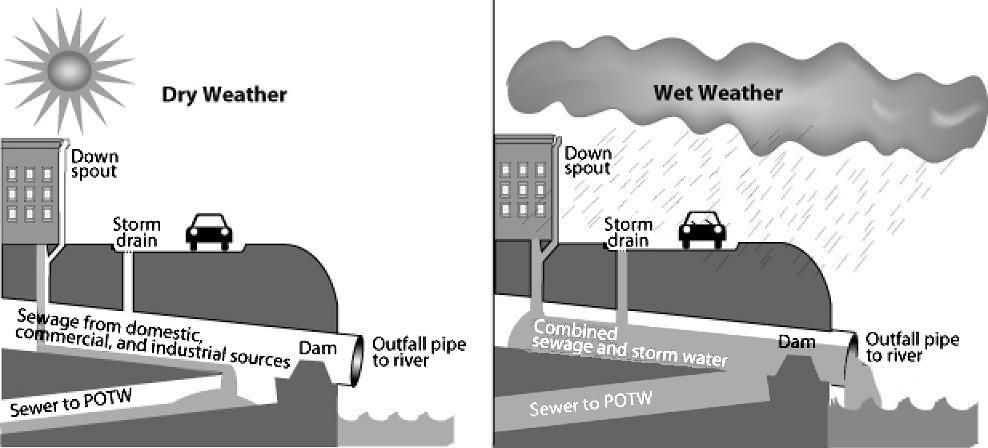Milwaukee Sewer History
The City of Milwaukee began construction of a public sewer system more than 130 years ago to carry wastewater to the surrounding rivers and to Lake Michigan. This design was insufficient for numerous reasons: the population of the area was too great, the waters smelled horrible, and there were fears of disease and contaminated drinking water. In 1888, the government took the approach of diluting the polluted waters with clean water from Lake Michigan. They built a flushing tunnel, which pumped water from Lake Michigan into the stagnant Milwaukee River, just below the North Avenue Dam. In 1907, a similar pumping tunnel was constructed in the Kinnickinnic River.
To help relieve the odor that was being noticed in the lower portions of the Milwaukee River, the city decided to construct a flushing tunnel. This tunnel would allow the pumping of water from Lake Michigan to be diverted to the lower river. However, this unfortunately brought about the possibility of diseases such as cholera and typhoid entering the drinking water. To help alleviate these problems, city officials approved the installation of pumping stations and streets mains in 1887. This provided chlorine-treated, Lake Michigan drinking water for the city residents.
With a typhoid scare in 1909, the formation of the Sewerage Commission of the City of Milwaukee was created in 1913. Their job was to design and to build a complete treatment and disposal system for the city’s waste. The Commission was one of the first in the nation to support secondary wastewater treatment. Built in 1925, the Jones Island Wastewater Treatment Plant used the activated sludge method (using microorganisms to feed on the pollutants) to clean the water.
As the population of the area continued to grow, so did the area’s sewage system and additional treatment plants and sewer lines were built. By 1977, work began on planning and constructing Milwaukee’s Deep Tunnel system. This system of over 17 miles of tunnels, 300 feet below ground, is the cornerstone of the Milwaukee Water Pollution Abatement Program, which was designed to trap sewer overflows.

Inflow & Infiltration
Inflow and infiltration (or I & I) are terms used to describe the ways in which groundwater and stormwater enter into dedicated wastewater or sanitary sewer systems. Dedicated wastewater, or sanitary sewers, are pipes that are located in the street or on easements, which are designed strictly to transport wastewater from sanitary fixtures inside your house or place of business. Sanitary fixtures include toilets, sinks, bathtubs, showers and lavatories.
Inflow is stormwater that enters into sanitary sewer systems at points of direct connection to the systems. Various sources contribute to the inflow, which include footing/foundation drains, roof drains or leaders, downspouts, drains from window wells, outdoor basement stairwells, drains from driveways, groundwater/basement sump pumps, and even streams. These sources are typically improperly or illegally connected to sanitary sewer systems, via either direct connections or by discharge into sinks or tubs that are directly connected to the sewer system. An improper connection lets water from sources other than sanitary fixtures and drains to enter the sanitary sewer system. That water should be entering the stormwater sewer system or allowed to soak into the ground without entering the sanitary sewer system.
Infiltration is groundwater that enters sanitary sewer systems through cracks and/or leaks in the sanitary sewer pipes. Cracks or leaks in sanitary sewer pipes or manholes may be caused by age-related deterioration, loose joints, poor design, installation or maintenance errors, damage or root infiltration. Groundwater can enter these cracks or leaks wherever sanitary sewer systems lie beneath water tables or wherever the soil above the sewer systems becomes saturated. Often sewer pipes are installed beneath creeks or streams because they are the lowest point in the area and it is more expensive to install the pipe systems beneath a roadway. These sewer pipes are especially susceptible to infiltration when they crack or break and have been known to drain entire streams into sanitary sewer systems. Average sewer pipes are designed to last about 20-50 years, depending on what type of material is used. However, often sanitary sewer system pipes along with the lateral pipes that are attached to households and businesses go much longer without inspection or repair and are therefore more likely to be cracked or damaged.
Inflow and Infiltration water is called “clear water” (although it may be dirty) to distinguish it from normal sanitary sewage water in the sewer system.
